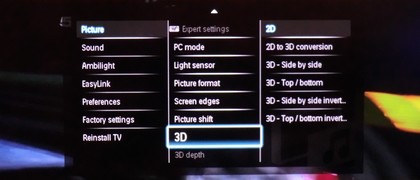Why you can trust TechRadar

Cover up the logo on front of the Philips 50PFL7956T and we would still know that this was a Philips TV. Not because of the shape – something only Phillips has experimented with – but because of its Pixel Precise HD engine.
The Philips 50PFL7956T arrived to us in its default settings, which meant all of its key slices of tech, including Perfect Motion Rate, Super Resolution and HD Natural Motion, were on their medium settings.
2D TV

Take Downton Abbey as a great example of how Philips addresses a TV's picture. This is a period drama, and on most TVs, appears as such. However, aside from cropping the top and bottom of the footage to make it fit the 21:9 panel, the Philips 50PFL7956T's circuitry creates a picture that is highly detailed, with an unusual depth even into 2D mode – so much so that some of the characters appear slightly divorced from the background.
Put simply, the out-of-the-box picture on the Philips 50PFL7956T looks processed, although whether that's a positive or negative depends on your point of view. We found that HD Natural Motion successfully put an end to blur and judder, especially from Blu-ray discs, although it is best left on its lowest setting. It's worth playing around with the settings (something that can be time-consuming) because simply switching off Pixel Precise HD's tech instantly softens the picture.
Put on a Blu-ray movie – in this case Black Swan – and the results are astounding. Presented in the correct aspect ratio, it's a real screen-filling treat. Watched in the well-judged ISF Night setting in a blackout, the detail is clean enough to please and colours remain on the right side of lifelike.
The contrast and peak whites are not as impressive as they could be, which is down to the use of Edge LED technology - it must work even harder to illuminate the bigger panel.
3D TV

Aside from the drop in brightness that active shutter 3D systems suffer (to say nothing of their glasses' high price and heavy design), 3D images on the Philips 50PFL7956T are punchy and lively. There is a noticeable drop in resolution (half the number of pixels are available to each eye when compared with active shutter screens) and horizontal lines are visible on the screen – the major reasons why passive 3D pictures aren't quite as involving, or as impactful, as active shutter 3D pictures.
Sign up for breaking news, reviews, opinion, top tech deals, and more.
Legends of Flight 3D from 3D Blu-ray provides some comfortable aeronautical excitement with a stack of well photographed sequences where the front effects aren't so in-yer-face as cinematic 3D fare. Donning the 3D specs does add a touch of contrast, but peak whites aren't clean and there was a slight lack of shadow detail inside the cockpit.
Those slight weaknesses of the panel are tempered by the fact that it's perfectly possible to watch 3D in a brightly-lit room – and there's not even a tinge of crosstalk. Easy 3D seems a wise move, but bear in mind that very few 3D movies have been released to make it a fair fight.
We're not sold on 2D-3D conversion, although the reason for its existence is simple: unless you like children's animation, there's really not much to watch in 3D. Still, the Philips 50PFL7956T's attempt at adding this to A Christmas Carol is rather lame.
When the credits roll, from three names presented on the screen, the bottom one is discernibly further forward than the others. There's very obviously an averaging-out algorithm at work that's not paying attention to what's being shown on the screen. Needless to say, the 3D effect in the movie itself was hugely random, yet occasionally impressive.
Gaming
A blast of Pro Evolution 2012 from an Xbox 360 looked simply awesome. The stretched aspect ratio really suits such games, and the Philips 50PFL7956T in Game mode provided crisp and blur-free results that were blighted only by the slight lack of contrast.
The Dual View mode works well indeed, with the exclusive view for two separate players really making a difference in a two-player game, something that brings a tactical change to the game play itself. It's an excellent trickle-down from 3D tech, and arguably both just as useful and similarly as limited, with both features giving fairly soft-looking images.

Jamie is a freelance tech, travel and space journalist based in the UK. He’s been writing regularly for Techradar since it was launched in 2008 and also writes regularly for Forbes, The Telegraph, the South China Morning Post, Sky & Telescope and the Sky At Night magazine as well as other Future titles T3, Digital Camera World, All About Space and Space.com. He also edits two of his own websites, TravGear.com and WhenIsTheNextEclipse.com that reflect his obsession with travel gear and solar eclipse travel. He is the author of A Stargazing Program For Beginners (Springer, 2015),
